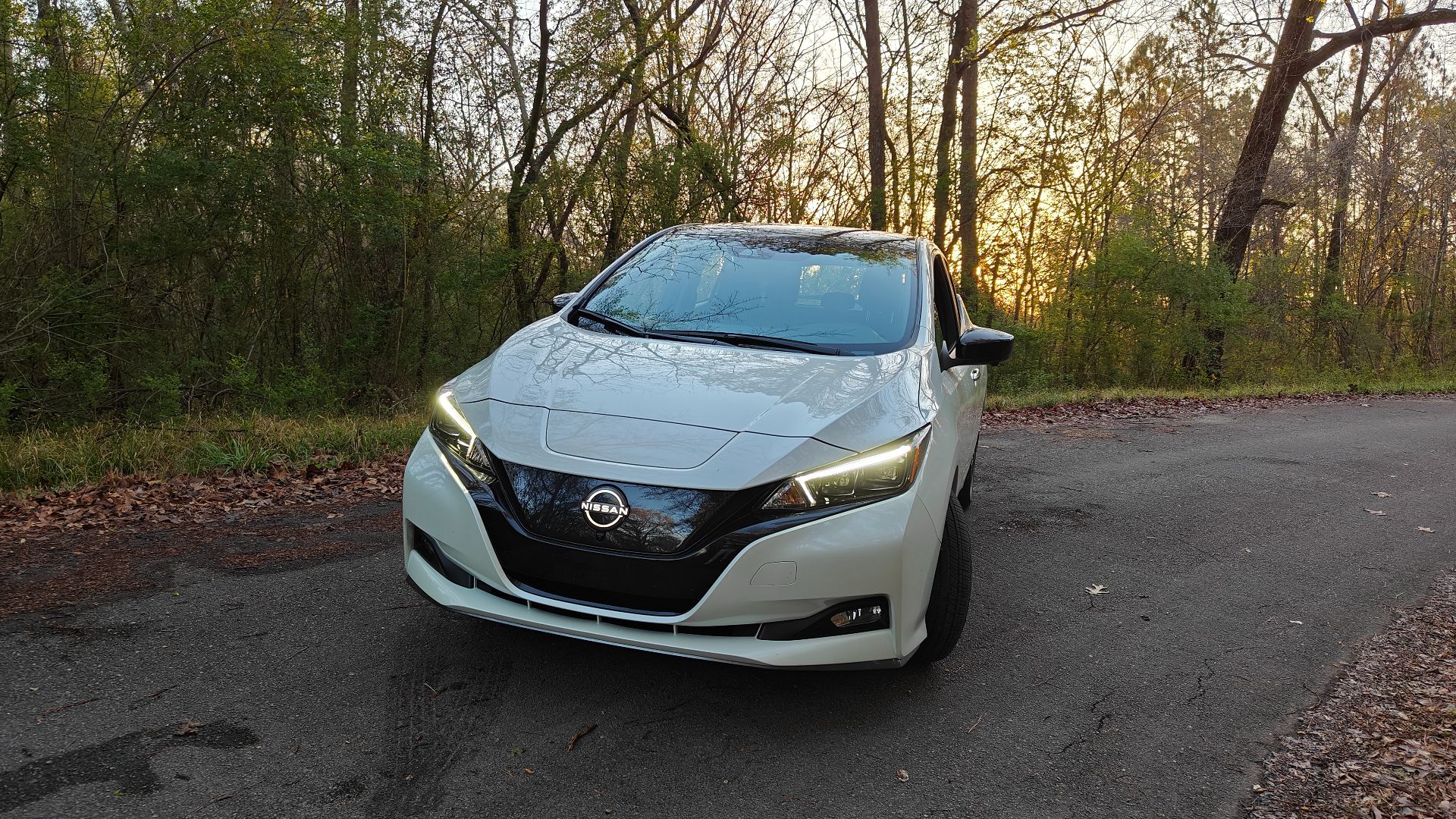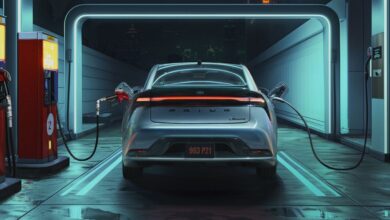An Overlooked Electric Vehicle Perfect For First-Time EV Buyers
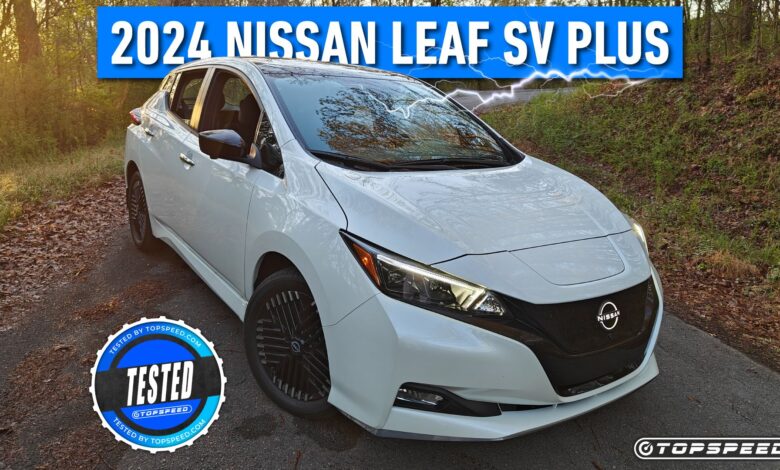
The Nissan Leaf, a pioneering EV in its time, continues to be a notable presence in the automotive industry. Though it may no longer be the cutting-edge option it once was, the Leaf has transitioned into a more accessible and affordable entry point for those seeking to embrace sustainable transportation.
During its early years, the Leaf was a trailblazer, outpacing its hybrid counterparts with its silent and emission-free operation but with a very small range of 70 to 100 miles. Today, while it may not be the chart-topping model it once was, the Leaf stands out as a welcoming gateway to electric car ownership. Offering a handshake to those not looking to sell a kidney for a taste of the future. A sort of “electric vehicle lite,” perfect for dipping your toes in the EV pool without diving wallet-first into the deep end.
2024 Nissan Leaf SV Plus Hatchback
The 2024 Nissan Leaf is one of the last EVs that can trace its lineage to the start of the EV craze in 2011. It has excellent build quality, but lacks features that are standard on other EVs in its class.
- Model
- Nissan Leaf SV Plus
- Engine
- 160 KW AC Synchronous Electric Motor
- Transmission
- Direct Drive
- Horsepower
- 214 HP
- Torque
- 250 LB-FT
- Driveline
- FWD
- Range
- 212 Miles
- MSRP
- $36,190
- Charge Time
- 11 Hours On 240-Volt AC
- Practical for Urban Commutes
- Excellent Build Quality
- Ample Storage Space
- Affordable in Select Trim Levels
- Short Range
- Lackluster Interior
- Slow Charge Time
- Outdated Charging Type
This 2024 Nissan Leaf SV Plus was a courtesy loan from the Nissan Media Relations Team, and I spent a full week getting to know it. For charging, I relied on a mix of public charging stations at a local dealership and mall. For detailed insight into testing procedures and data collection, please review
our methodology policy
.
The Nissan Leaf we had the opportunity to evaluate was the top-tier SV Plus trim level. The Nissan Leaf SV Plus sports 17-inch machine-finished aluminum-alloy wheels, lending it an attractive stance on the road. It boasts NissanConnect with Services powered by SiriusXM, offering a suite of connected features and a trial subscription for enhanced infotainment. Notably, our test vehicle also included the Nissan ProPILOT Assist system, which combines adaptive cruise control and lane-keeping assistance for a more relaxed driving experience.
Under the sleek exterior, the Leaf SV Plus houses a 60-kWh battery that provides an EPA-estimated 212-miles of range. While the Nissan Leaf may no longer be the poster child for cutting-edge EV technology in 2024, it serves as a bridge between the past and the present. Offering a glimpse into a future where electric cars are not just for the tech-savvy or the environmentally conscious, but for everyone.
2024 Nissan Leaf SV Plus First Impressions
The Nissan Leaf has undergone a remarkable evolution since its debut in 2010 as one of the first mass-market electric vehicles in the United States. What started as an extremely compact car has matured over the years into a more spacious and luxurious offering. The current model, equipped with a 60-kWh battery pack in the SV Plus trim, achieves an EPA-estimated range of 212 miles through a combination of city and highway driving. While not quite unlocking the vehicle’s full highway range potential, this estimate reflects realistic mixed usage.
With decent acceleration to merge onto freeways and an exterior build quality showing no noticeable panel gaps, the Leaf has grown into a well-rounded modern EV.
Unfortunately, Nissan has decided it’s time to retire the Leaf. Yes, the little electric hatchback that could is making its final lap around the sun, with production hitting the brakes in 2025. In its place, Nissan is queuing up something a bit beefier for 2026—a larger electric SUV.
“This isn’t just a change of pace; it’s Nissan tuning into the electric car playlist and realizing everyone’s dancing to the SUV rhythm these days.”
The Leaf, bless its battery-powered heart, will pass the eco-friendly torch to this next-gen model, ushering in a future where Nissan’s electric dreams are bigger, bolder, and ready to rumble with the heavyweights of the EV world. Owning the Nissan Leaf comes with an added layer of convenience through the EV Carefree+ package. The all-inclusive program aims to reduce stress and provide enhanced peace of mind for LEAF drivers. Benefits include scheduled maintenance coverage, assistance with EV charging, battery health assurance, and roadside assistance services specifically tailored for electric vehicles.
Exterior Dimensions
|
Length |
176.4 Inches |
|
Width |
70.5 Inches |
|
Height |
61.7 Inches |
|
Wheelbase |
106.3 Inches |
|
Front Track |
60.2 Inches |
|
Rear Track |
60.8 Inches |
|
Curb Weight |
3,901 LB |
Driving Impressions And Performance
Driving the Nissan Leaf is a bit like taking a ride on a futuristic, eco-friendly magic carpet. It’s all electric, so the steering feels as light and responsive as if it were powered by good intentions and positive thoughts. But, throw in some spirited acceleration or treat it to a cheeky swerve, and the Leaf will lean into those moves with the enthusiasm of a puppy on laminate flooring, thanks to its marshmallow-soft suspension that’s more about soaking up bumps than carving corners.
Then there’s the e-Pedal technology, Nissan’s clever but polarizing party trick for the stop-start dance of urban traffic. It’s like having a magic wand for your feet; push down to zoom forward and ease off to smoothly come to a halt, all with a single pedal. This wizardry uses regenerative braking, which is basically turning kinetic energy into electrical energy (or making lemonade out of lemons, if you will). It’s up to three times more effective than your average engine brake at slowing you down, making the e-Pedal not just a neat feature but a glimpse into the future of driving.
While offering regenerative braking that provides excellent stopping power on its own, the Nissan Leaf does have a couple of quirks to its braking system. The e-Pedal feature requires manual enabling each time the driver enters the vehicle rather than being a default setting. However, this minor inconvenience is offset by the impressive braking feel and performance afforded by the regenerative braking system.
There’s plenty of stopping power on tap from the e-Pedal alone without needing to apply the traditional friction brakes in most situations.
While the 2024 Leaf delivers a capable electric driving experience, it’s not ideally suited for extended highway journeys. Instead, the Leaf shines brightest as an urban runabout, thriving in stop-and-go city environments where its electric powertrain can maximize efficiency. The sweet spot for battery range is at posted speeds between 55-65 mph. However, strenuous uphill terrain can put a noticeable dent in driving range, with the battery potentially draining 1-2% more quickly when tackling steep grades. For drivers who spend most of their time navigating city centers rather than conquering long stretches of interstate.
Braking And Acceleration
When the need for speed arises, such as overtaking on the interstate, it showcases subpar acceleration from 60 to 80 mph. At slower speeds, the instant torque allows for effortless merging into traffic at city speeds, leaving you without a desire for more power.
The braking abilities of the 2024 Leaf are a pleasant surprise. The brakes offer exceptional firmness. In the e-Pedal Mode, the brakes become firm, instilling confidence during emergency braking maneuvers.
- Acceleration 0-60 MPH: 6.9 Seconds
- Braking: 60-0 MPH: 2.8 Seconds
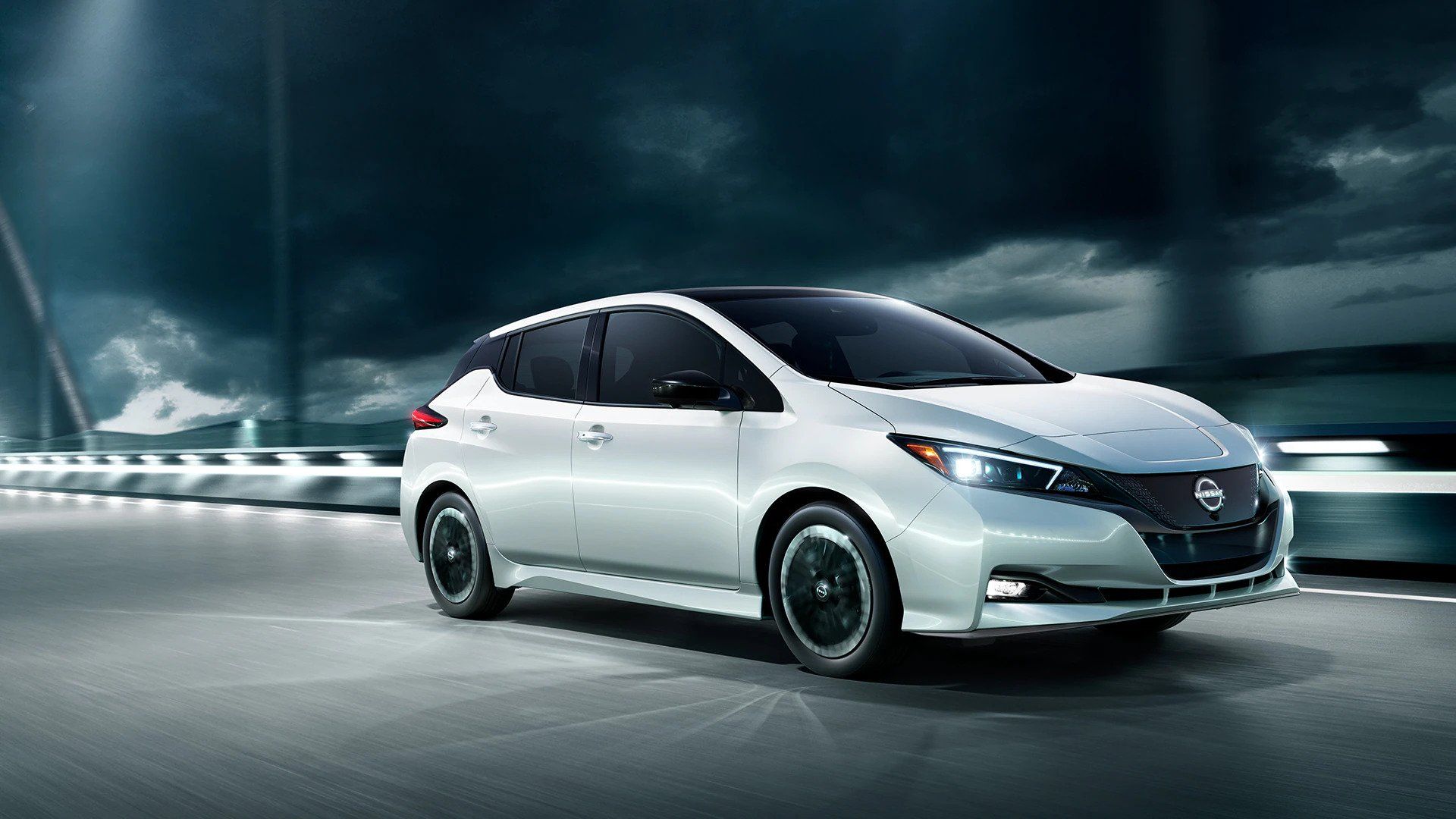
10 Things To Know About The Nissan Leaf
The Nissan Leaf has been around for a while, but it is still a great entry-level EV. Here’s everything you should know about it.
Performance Specifications
|
Transmission |
Single-speed automatic transmission |
|
Horsepower |
214HP |
|
Torque |
250LB-FT |
|
Motor EVs/Hybrids only |
160 kW AC synchronous electric motor |
|
Battery EVs/Hybrids only |
60 kWh lithium-ion battery |
|
Fuel Economy (CMB) |
109 MPGe |
|
0-60 MPH |
6.7 Seconds |
|
Top Speed |
92MPH |
2024 Nissan Leaf SV PLUS Fuel Economy
|
City |
Highway |
Combined |
|
|
EPA Rated Economy |
121MPGe |
98MPGe |
109MPGe |
|
Fuel Economy As Tested |
105MPGe |
Interior Design And Comfort
The Nissan Leaf’s interior offers a balanced blend of comfort and technology. Cloth seats provide a simple yet cozy cabin, with heated front seats and a heated steering wheel – a luxurious touch for those brutally cold mornings when staying bundled up indoors is tempting. Despite the quiet electric powertrain which amplifies wind noise at times, the Leaf exhibits excellent soundproofing and a solid, rattle-free build quality that elevates the driving experience.
Practicality is also a strength, with visibility aided by the 360-degree camera view when reversing, and a rear seat with enough legroom for most adults under 6 feet tall.
The front seats offer a wide range of power adjustments to accommodate varying body types. While the interior of the leaf boasts excellent fit and finish overall, you may find yourself searching for a splash of color, a hint of personal flair, and… well, it’s like being in a tuxedo shop where they only sell black. That’s right, the Leaf’s interior only comes in monochrome, offering up a single shade of “you better like black because that’s all you’re getting.” It’s a bit of a letdown for those dreaming of personalizing their ride or just breaking free from the grayscale monotony.
Interior Dimensions
|
Front |
Rear |
|
|
Headroom |
41.2 Inches |
37.3 Inches |
|
Shoulder Room |
54.3 Inches |
52.5 Inches |
|
Hip Room |
51.7 Inches |
50.0 Inches |
|
Legroom |
42.1 Inches |
33.5 Inches |
Technology And Ease Of Use
The Nissan Leaf keeps things simple with its infotainment system and dashboard layout. Android Auto integration is straightforward and user-friendly, without any glaring issues or problematic interfaces to contend with. Instead of following competitors’ trends of innovative but sometimes distracting tablet-styled digital dashboards, the Leaf has a more traditional and intuitive instrument cluster design.
Cargo And Storage Space
Despite its compact size, the Nissan Leaf offers impressive practicality with ample cargo space and clever storage solutions throughout the cabin. While the center console area is on the smaller side, it’s compensated by an easy-to-load trunk with a low lift-over height that makes stowing items a breeze, even for those with limited mobility. Small item storage abounds as well to keep the cabin tidy.
The Nissan Leaf, while nifty with its electric zippiness, seems to have missed a memo on the EV cool factor: the frunk, or front trunk. It’s like showing up to a magician’s convention without a rabbit or a hat—where’s the fun in that? Most electric vehicles use that prime real estate under the hood, where the engine used to be, to add a little extra storage space. It’s a neat feature that lets owners flaunt their car’s electric credentials, sort of like saying, “Look Mom, no engine!”.
|
Minimum Cargo Capacity |
23.6 Cubic-Feet |
|
Cargo Capacity Second-Row Rear Seats Folded |
30.0 Cubic-Feet |
2024 Nissan Leaf Vs. Its Competitors
While the Tesla Model 3 represents the Nissan Leaf’s most direct rival in the EV arena, these two vehicles were conceived with fundamentally different purposes in mind. The Model 3 is very much a performance-oriented tech marvel aimed at delivering an electrified driving experience on par with gas-powered sports sedans. Its potent acceleration, sharp handling dynamics, and cutting-edge minimalist interior all serve to elevate the emotional passion behind the wheel instead of being just a utilitarian vehicle.
On the other hand, the Leaf isn’t trying to be the flashiest car on the block or the speed demon at the traffic lights. Instead, it’s the reliable friend that’s all about getting you around town with zero fuss and zero emissions. It’s designed with the city dweller in mind, offering a compact size that makes parking a breeze, zippy enough to zip through traffic, and controls that don’t require a tech wizard to figure out. Nissan’s trailblazer in the electric vehicle world isn’t about making your heart race; it’s about offering a sensible, green alternative for your daily commute.
How The Make Model Compares To The Tesla Model 3
-
2024 Nissan Leaf SV Plus Hatchback 2024 Tesla Model 3 Long Range Model Nissan Leaf SV Plus Long Range Engine 160 KW AC Synchronous Electric Motor Front Induction AC Motor/ Rear Permanent-Magnet Synchronous AC Motor Transmission Direct Drive 1-Speed Direct Drive Horsepower 214 HP 394 HP (Combined) Torque 250 LB-FT 377 LB-FT (Combined) Driveline FWD AWD Range 212 Miles 341 Miles MSRP $36,190 $47,740
For city dwellers who primarily stick to an urban routine with occasional inter-city jaunts, the Nissan Leaf makes a compelling, affordable EV choice. Its compact size and 98 MPGe highway rating make it well-suited for navigating dense areas and shorter driving distances. However, the Leaf’s efficiency advantages start to diminish when venturing beyond its metropolitan comfort zone.
Rivaling EVs like the Hyundai Ioniq 6 and Tesla Model 3 significantly outpace the Leaf’s highway mpg-e ratings at 126 MPGe for the Model 3. Their longer driving ranges and rapid charging capabilities give them a clear edge for road trips and long-distance highway travel. Many Leaf owners on enthusiast forums even recommend renting a more highway-capable vehicle when undertaking extended journeys to avoid compromising the optimal EV experience.
Performance
Straight-line acceleration reveals a sizable performance gap between these two EVs. The rear-wheel drive Tesla Model 3 can sprint from 0-60 mph in a quick 5.8 seconds when equipped with the base single-motor powertrain. The front-wheel drive Nissan Leaf SV Plus takes a more leisurely 6.9 seconds to achieve the same benchmark despite its instant torque delivery. The Model 3 simply has more outright muscle with 283 lb-ft of torque compared to the Leaf’s 260 lb-ft.
However, the handling dynamics tilt slightly in favor of Nissan’s urban runabout on tighter city streets. Thanks to its shorter wheelbase, the Leaf exhibits agility and responsiveness that makes it quite tossable and fun to hustle around corners. The Model 3 is certainly no handling slouch, but its longer footprint gives it more of a planted, substantial feel that’s better suited for highway cruising.
Comfort
When it comes to overall interior design flair, the Tesla Model 3 has a distinct advantage over the Nissan Leaf. Tesla’s minimalist interior aesthetic provides a truly premium ambiance with high-quality materials, elegant simplicity, and an array of upscale options like heated seats, sunroof, and a premium audio system. The Leaf’s cabin, while functional and spacious for its size, comes across as relatively basic and lacking the same upscale ambitions.
However, the Model 3’s interior quality advantages are somewhat offset by inconsistencies in overall build quality and fit and finish that its rivals like the Leaf and Ioniq 6 seem to better execute.
Technology
When it comes to in-cabin technology, the Tesla Model 3 and Nissan Leaf SV Plus take diverging philosophies. Tesla’s interior almost entirely eliminates physical buttons and knobs in favor of a sleek, tablet-like 15-inch touchscreen that commands nearly every vehicle function and setting. This ultramodern approach is equal parts futuristic and polarizing – reducing clutter but also potentially increasing distraction.
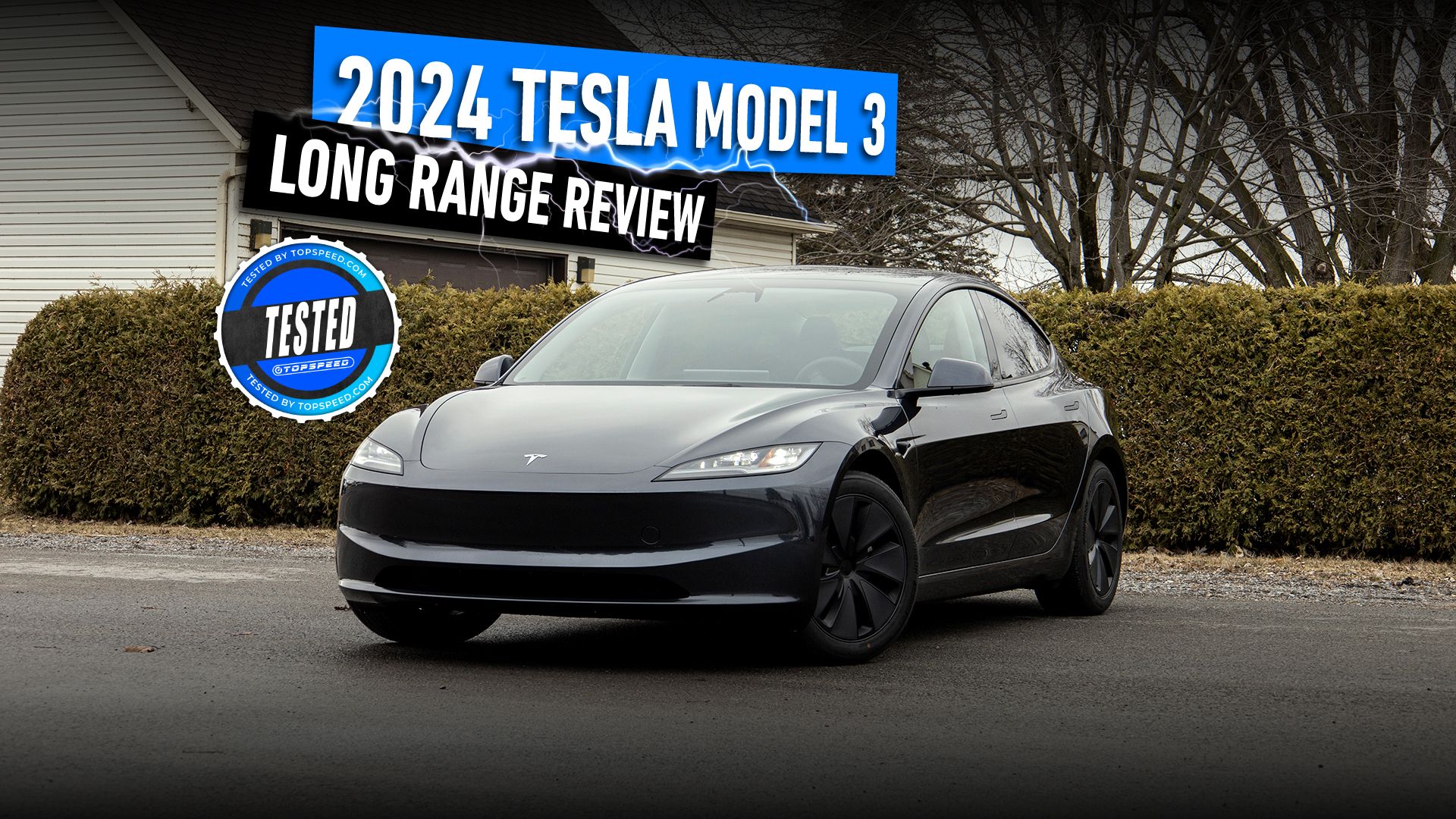
2024 Tesla Model 3 Long Range First Drive : Finally Matured Into A True Premium Product
At first glance, the 2024 Tesla Model 3 may not appear different, but it’s the fine details that have allowed it to morph into a much better car.
Our Recommendation For Which Model You Should Buy
While the Nissan Leaf holds its own as a well-built and practical electric vehicle, it faces stiff competition from newer entrants like the Tesla Model 3 and Hyundai Ioniq 6 which boast superior range and charging speeds. However, the Leaf offers a more refined overall driving experience and solid build quality that gives it an edge over Tesla’s sometimes inconsistent manufacturing standards.
As legacy automakers like Nissan and Chevy move to phase out first-generation affordable EVs like the Leaf and discontinued Bolt, they are pivoting to develop second and third-generation electric models that learn from those pioneering efforts. The goal is to deliver more mature, robust EVs that don’t feel like perpetual beta tests on the road. While low-margin trailblazers like the Leaf primarily served as compliance plays to generate emissions credits, the next wave of electric vehicles will need to be profitable high-volume products that can drive mass EV adoption.
With the Nissan Leaf entering its twilight years, budget-conscious buyers would be wise to consider the value-oriented S trim as their go-to choice. Given the Leaf’s urban-focused strengths, the S capabilities are well-suited for making short jaunts around city streets its prime mission rather than tackling extended highway travel. As Nissan prepares to sunset this pioneering affordable EV and transition to its next-generation electric lineup, the cost-effective S represents a sensible sweet spot for those seeking an efficient urban runabout from the Leaf’s final model years.
